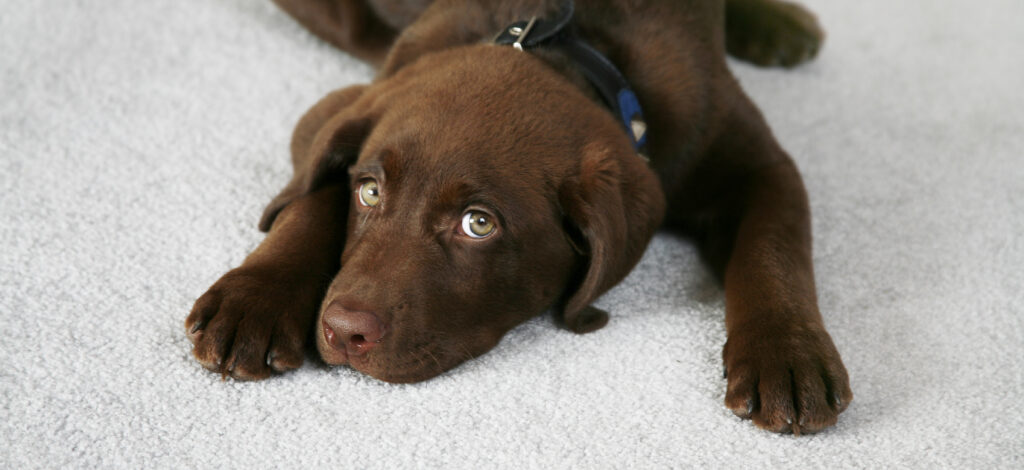What’s in Pet Urine & Why Does It Stain Carpet?
Urine is made up of several waste products of metabolism such as urea, creatine, cholesterol (lipids), and uric acid. Another component called urochrome gives urine the yellow color. The exact make up depends on the animal’s diet, health, age, and other factors.
Urine leaves the body as an acid, but immediately begins to be broken down into ammonia and carbon dioxide. The ammonia is highly alkaline (ph 11+) and can damage dyes and create permanent color loss. So, what looks like a urine stain may actually be color loss that cannot be corrected with cleaning.
Why Do Urine Stains Have an Odor?
When urine leaves the body, it comes in contact with bacteria in the urethra, the animal’s skin, and microorganisms in the carpet. The warm acid environment is the perfect breeding ground for bacteria, which begin to flourish. The bacteria give off gasses, which is one component of the odor we smell.
As the urine decomposes it changes in pH from an acid to an alkali. Alkaline salt crystals from when the acidic urine reacts with the ammonia being created. These hygroscopic salts draw moisture from the air and remain slightly moist and chemically active. As long as it remains active it will produce ammonia gasses. Dried urine salts will give off more ammonia gas once re-moistened, which is why the odor is stronger on humid days or after cleanings.
Why should urine stains be treated as soon as possible?
Besides the obvious health and sanitary issues left untreated, urine causes difficult to remove yellow stains, or worse yet, dye loss. Over time as urine sits in your carpet it becomes highly alkaline, and can bleach out primary carpet dyes until your left with a yellowish or white discoloration. At that point the only option to repair the damage is to re-dye the spot or patch the carpet.
Does the age of the animal affect the degree of the odor?
Absolutely, in younger animals the kidneys function perfectly, filtering waste out of the pee. In older animals the kidneys don’t filter waste as well, and as a result the odor becomes more pronounced.
How do you locate the pet odors and stains?
Although not recommended, many stains are located when stepping barefooted on a new one! Male pet deposits are usually found near furniture or walls to mark their territory, and female pets generally out in the open areas. We use a combination of UV lights, a moisture probe, and smell to locate difficult to find pet odors and stains. Once located, we mark the area with chalk so we can return later to treat the area.
Why does the pet stain and odor keep returning?
Although a pet stain may look small on the surface it can be 2-3 times the size underneath. Just a few ounces of urine can quickly soak deep into the carpet backing, the padding, and even the sub floor. A topical treatment may temporarily mask the odor and stain, but any remaining contamination in the carpet pad & sub floor will quickly creep back to the surface. In this case a more thorough treatment is needed, such as our subsurface extraction method.
Can I remove the odor and stain myself?
Many pet owners attempt to treat urine stains with products recommend by their local pet store or even regular household products. While you may have some success in masking the stain or odor, it is almost impossible to completely remove the source of the odor and stain, which lie in the carpet backing and pad, without the use of professional equipment and cleaning solutions.
In fact pet stains and odors are so complex and difficult to remove, many carpet-cleaning companies don’t have the knowledge or equipment to properly treat these stains. So before hiring anyone, be sure to ask about the chemicals, procedure, and equipment that they use specifically for pet stains.
However, if you decide to attempt to treat these stains yourself here are some things to keep in mind:
- Using absorbent powders – 80% of the animal’s urine is in the pad and sub floor, totally out of reach of the powder.
- Odorcides, disinfectants – These are effective at killing bacteria, however the urine remains. Leaving behind urine provides a food source for new bacteria, and along with the new bacteria the odor will return.
- Vinegar – Never apply vinegar to a fresh urine stain, just as you set dyes in Easter eggs, Vinegar will set stains in carpet. However the idea of using Vinegar is on the right track, because it can neutralize the ammonia in the urine to remove 1 part of the odor.
- Oxy products – We do not recommended using these products on carpet. There is absolutely no benefit for odor, and it can actually bleach out the carpet.
- Ammonia solution – Used properly ammonia is fine for urine stains, but will not help with odors.
- Citrus scents – Citrus or any other scents will do nothing more than mask the odor and provide short-term relief.
- Shampoo/Wet Vac – A Shop Vac or Wet Vac will only remove liquid from the face fibers, and not the carpet backing, pad, or sub floor. Wetting the carpet and pad spreads out the contaminated area, attracting more bacteria and the odor worsens. Even with our powerful truck mounted vacuums we still need to use a special sub surface extraction tool, used in flood restoration, to remove the odor and stain from deep within the carpet.
We do not recommend attempting to remove any stains without first consulting a professional. Many household products can cause permanent damage to carpet and even the right chemicals used incorrectly can cause more harm than good. Contact Mighty Clean Carpet Care to schedule a professional pet stain removal.


Leave A Comment
You must be <a href="https://mightycleancarpetcare.com/wp-login.php?redirect_to=https%3A%2F%2Fmightycleancarpetcare.com%2F2021%2F01%2F07%2Fpet-urine-stains-odors-frequently-asked-questions%2F">logged in</a> to post a comment.